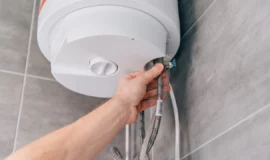
Ceiling fans have been one of our most reliable companions to fight off the summer heat long before air coolers and air conditioners even existed. They are a budget-friendly and power-efficient solution to provide relief from soaring temperatures. The old ceiling fan watts were as high as some of the air coolers these days. But now, the ceiling fan’s electricity consumption has reduced drastically with the latest technology.
Despite their popularity, you may still be unaware of ceiling fan watts in Pakistan and how much it exactly costs to run. This blog will answer your questions by calculating the average energy consumption of a ceiling fan and provide you with an estimated range of its cost as well.
Let’s begin!
Ceiling Fan Watts in Pakistan
In Pakistan, the conventional ceiling fan power consumption is 80w, whereas some new AC/DC fans consume 50w to 60w. However, there is a special type of fan commonly known as 30w ceiling fans that consume 30 watts.
The electricity consumption of a fan depends on several factors, which include brand, number of hours used, its size, speed, and revolutions per minute. So, it can vary as per these factors.

Conventional Ceiling Fan Watts, Energy Consumption, and Cost
The traditional ceiling fan can consume around 80 watts on average. Let’s see their cost and electricity consumption per day and month.
| Ceiling Fan Watts (W) | Avg. Number of Hours Used | Avg. Daily Usage (kWh) / Units | Avg. Electricity Cost (per day) | Avg. Electricity Cost (per Month) |
| 80W | 16 | 1.28 | Rs. 27 to Rs. 46 | Rs. 800 to Rs. 1400 |
AC DC Fan Watts, Electricity Consumption, and Cost
The watts of AC/DC fans vary and can go up to 60w. If you are interested in the AC DC fan wattage and electricity cost, check out the table below:
| Ceiling Fan Watts (W) | Avg. Number of Hours Used | Avg. Daily Usage (kWh) / Units | Avg. Electricity Cost (per day) | Avg. Electricity Cost (per Month) |
| 60W | 16 | 0.96 | Rs. 20 to Rs. 35 | Rs. 600 to Rs. 1050 |
| 50W | 16 | 0.8 | Rs. 17 to Rs. 29 | Rs. 500 to Rs. 880 |
30-Watt Ceiling Fan, Power Consumption, and Cost
30-watt ceiling fans are considered the most energy-efficient fans in Pakistan. Here are their power consumption and costs:
| Ceiling Fan Watts (W) | Avg. Number of Hours Used | Avg. Daily Usage (kWh) / Units | Avg. Electricity Cost (per day) | Avg. Electricity Cost (per Month) |
| 30W | 16 | 0.48 | Rs. 10 to Rs. 17 | Rs. 300 to Rs. 530 |
Disclaimer: The rate of units may vary according to the slabs of electricity and the variation in the fan power consumption.

Why Choose a Low-Watt Ceiling Fan?
Choosing an energy-saver fan is important in many ways, as there are several benefits associated. The main benefit is obviously the cost-cutting, as you have seen that the average monthly cost of a 30-watt ceiling fan is Rs. 300 to Rs. 500, whereas the average cost of an 80-watt ceiling fan is Rs. 800 to Rs. 1,400, nearly a 3x difference.
The second benefit is that they mostly come with a remote control, making them convenient to control. Thirdly, their noise levels are generally lower compared to the older models. Also, as they consume less energy, the UPS backup time might increase if you use power-efficient fans.
Ceiling Fan Price in Pakistan
The price of a ceiling fan in Pakistan can range between Rs. 6,000 and Rs. 25,000. Moreover, the price is dependent upon its condition, brand, buying source, and availability in Pakistan. If interested in buying a ceiling fan, you can check out OLX.
Best Ceiling Fans in Pakistan
Here are the wattage and electricity consumption of some of the most popular ceiling fans in Pakistan.
Royal Passion Grace – Prime ACDC Ceiling Fan
Royal Passion Grace is one of the best AC DC fans in Pakistan. Check out its watts, price, and average electricity cost in Pakistan.
- Power Consumption: 53 watts
- Price: Rs. 9,695
| Ceiling Fan Watts (W) | Avg. Number of Hours Used | Avg. Daily Usage (kWh) / Units | Avg. Electricity Cost (per day) | Avg. Electricity Cost (per Month) |
| 53W | 16 | 0.848 | Rs. 18 to Rs. 31 | Rs. 530 to Rs. 930 |
GFC Alpha Wooden
GFC Alpha is a popular conventional type of fan in Pakistan. Here are its watts, price, and average electricity cost in Pakistan.
- Power Consumption: 80 watts
- Price: Rs. 9,995
| Ceiling Fan Watts (W) | Avg. Number of Hours Used | Avg. Daily Usage (kWh) / Units | Avg. Electricity Cost (per day) | Avg. Electricity Cost (per Month) |
| 80W | 16 | 1.28 | Rs. 27 to Rs. 47 | Rs. 800 to Rs. 1,400 |
Pak Fan Diamond Antique Small Eco Max
The Diamond Antique Small Eco Max is an energy-efficient ceiling fan offered by Pak Fan. Let’s see its power consumption, price, and electricity costs in Pakistan.
- Power Consumption: 30 watts
- Price: Rs. 12,500
| Ceiling Fan Watts (W) | Avg. Number of Hours Used | Avg. Daily Usage (kWh) / Units | Avg. Electricity Cost (per day) | Avg. Electricity Cost (per Month) |
| 30W | 16 | 0.48 | Rs. 10 to Rs. 18 | Rs. 300 to Rs. 530 |
If you are interested, check out the best ceiling fans in Pakistan, with prices and specs.
Conclusion
To sum it up, by knowing the ceiling fan watts and daily ceiling fan electricity consumption, you can get an idea of its average monthly cost. Many companies offer power-efficient 30-watt ceiling fans, which can reduce the electricity consumption by up to 3x compared to conventional fans.
With this guide, you can calculate the watts and cost of the fan you have installed or want to buy. Moreover, if you are interested in learning about the average electricity consumption of inverter ACs in Pakistan, our blog can help you.
FAQs
On average, a ceiling fan can consume around 30 watts to 80 watts to run. The power consumption can vary based on the model, brand, fan speed, and many other factors.
In one hour, a ceiling fan can use from 0.03 kWh to 0.08 kWh of electricity.
The cost to run a ceiling fan in Pakistan can vary from Rs. 19 to Rs. 88 depending on the wattage of fan, its speed, model, etc.
1 unit is generally 1000 watt-hours (Wh) or 1 kilowatt-hour (kWh) in Pakistan.
Ceiling fans are mostly designed for prolonged usage, i.e., 24/7. But it’s recommended to give it breaks in between for improved durability.








Leave a Reply